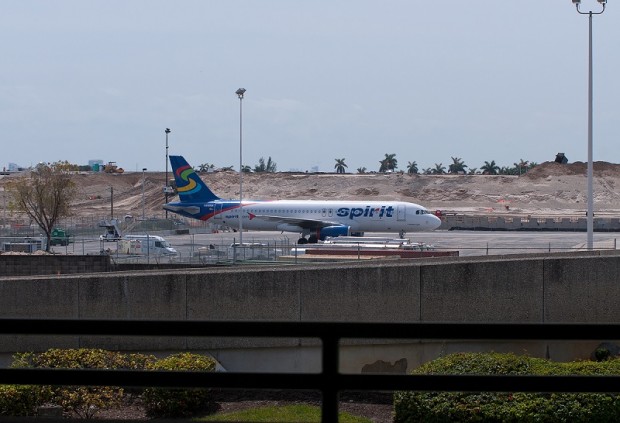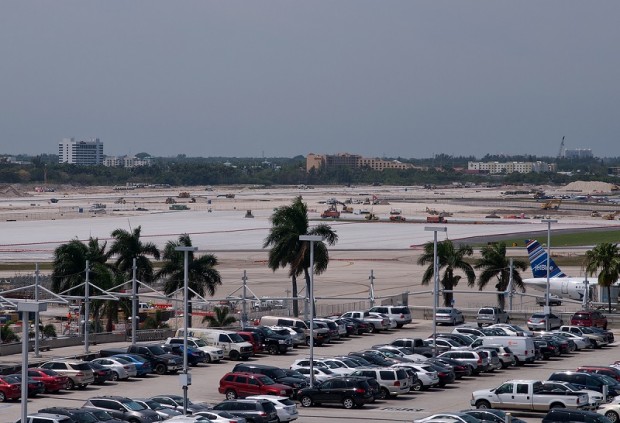It’s been a year since we originally reported on the massive changes happening at Fort Lauderdale/Hollywood International Airport (FLL) with the new runway construction and terminal changes. With the closure of the Airport Hilton on April 1st to prepare for demolition and new Runway 10R/28L set up open on September 18th of this year, I returned to the airport to see how the changes are progressing.
Work is still continuing like mad with trucks and vehicles moving all over the construction site like ants. The raised portion of the Runway 10R/28L extension, which passes over U.S. 1 and an adjacent rail line, is complete and vehicle traffic is now using the new tunnels that run under the extended runway. Taxiways and holding points are under construction with a lot of the concrete for these already poured. While I personally think September 18th is going to be a tough goal to reach with the Florida rainy season approaching, it sure is going to be a stunning engineering feat when it is completed with a runway raising 6 stories into the air over a length of 8,000 feet.
One of the issues that this new construction has raised is the ability of aircraft to access Terminal 4, which is the International terminal at FLL. During the construction time, almost daily service from Scandinavia (Oslo, Stockholm and Copenhagen) by Norwegian Air Shuttle has commenced using Boeing 787 equipment. This will also be extended during the summer with service from London Gatwick. There have also been charters operated by Thomas Cook Scandinavia using Airbus A330 equipment. Due to the construction, nothing larger than a Boeing 737-800 aircraft can use the taxiways around the south side of the airport to gain access to the International Terminal. So currently the larger aircraft are parking at Terminal B hard stands with passengers being bused around to the International Terminal. This situation is also going to persist for a period after the completion of the runway while new terminal construction is completed.
However, one of the larger issues over the winter months has been congestion. FLL always has large charter and foreign carrier traffic over the winter months bringing travelers to the sun from the northern states of the USA, Canada and destinations further away. Over this season, it has not been uncommon for visitors to the airport and spotters alike to see two lines of aircraft on Taxiways B and C totaling 18+ aircraft. For a large international airport, that is not an uncommon sight. However, for a smaller airport this is different and the FAA has been posting updates on delays to and from Fort Lauderdale of 30 minutes. I have approached various operators around the airport for comments. Russell J. Boy, General Manager of National Jets, an FBO based on the north side of the airport said “We are seeing delays for short periods, certain times of the day. It hasn’t been as big a problem as was predicted, but we have seen some speed bumps”.
I approached Tamara Young, Manager Corporate Communications for JetBlue about the affect on them during this period.
NYCAviation: With JetBlue being FLL’s biggest airline, what has the impact of the construction been to the airline?
Tamara Young: For a major airport operating on a one-runway configuration, certainly there have been some operational challenges. That said, the operational impact hasn’t been as severe as we anticipated. Certainly good weather and the aviation community as a whole not overscheduling operations has helped, but generally speaking, the impact has not been as great as originally anticipated. That said, there still will be delays.
NYCA: Are current operations requiring more time to get flights in the air?
TY: Yes, with airfield access constraints – like taxiways and taxi lanes unavailable – there are certain requirements for getting aircraft to and from the runway. With a one-runway configuration, there may be longer sequencing of aircraft from out-to-off or on-to-in for proper sequencing from a tower perspective. It is taking longer, but it’s all in perspective – Boston or JFK in bad weather will be much worse.
NYCA: Is more fuel being loaded for additional wait times?
TY: Yes, and it’s something we prepared for a one-runway operation because there is an impact to taxi times, flight times, and delays into upline cities. By the end of this year when we get the second runway back, the airfield will be more efficient and more customer and airline friendly.
As a closing comment, Tamara noted, “This investment will be well worth it. It will take some pressure off Miami – it’ll definitely make the experience more attractive than some of the larger airports. There is an impact because of the project, but the airport, ATC, the FAA and the county are doing a good job keeping the airlines and the general aviation community well informed about what’s going on.”
I was able to pose questions regarding this to Doug Webster, Deputy Director of Fort Lauderdale/Hollywood International Airport. He said that the FAA, a year and a half prior to this peak season at the airport, invested a great deal of time in ensuring that all carriers and operators in and out of FLL were treated equally. Many meetings were held between the carriers, the airport and all parties involved with the planning for this peak time. When the busy season arrived, the FAA introduced a defensive ground delay program purely for capacity planning. In a study completed in 2008, it was noted that during this period, delays of up to 50 minutes could be expected. Assessments after the fact have however noted that the delays have been significantly lower than this at around 30 minutes for the maximum delay. Mr. Webster went on to detail how the capacity at the airport has decreased since the closure of the small General Aviation runway (known previously as 9R/27L) and the crosswind runway (known previously as 13/31). Pre-construction, on easterly visual operations, the runways would handle 82 movements per hour. Now with only one runway operational, under the same easterly visual operations, the capacity dropped to 56 operations/hour decreasing further under instrument rules to 50 operations per hour. In westerly operations, which are not preferred at FLL due to the layout of the taxiways and airport configuration, capacity in visual flight rules dropped from 78 operations per hour to 48 operations per hour, although in instrument rules, this number did not change.
Mr. Webster noted that now that the peak season is over, the number of daily operations would drop from between 600 and 640 commercial flights per day to approximately 570 commercial flights per day, which will alleviate a lot of pressure on the operations of the airport. Generally, this peak season has gone off with the minimal of issues for all the operators at the airport and the operations staff of both the airport and the FAA.
As noted above, one of the next major milestones in the construction is the demolition of the Airport Hilton Hotel, located on the north side of Griffin Road in Dania Beach. This hotel lies directly in the flight path for the new Runway 10R/28L. The hotel, which opened for business in 1986, closed its doors to travelers on April 1st and is scheduled for demolition at the end of May or beginning of June. Broward County purchased the hotel recently for $62 million from Hilton in order to tear it down for the runway construction.

Construction of the raised runway extension. (Mark Lawrence)
(Special thanks to Doug Webster and Greg Meyer, PIO for Broward County Aviation Department for their time in compiling this article).
Mark Lawrence, Producer, is a South Florida-based aviation fanatic that has been around the industry since he was a small boy. As well as being an avid photographer, he also runs his own blog that can be found at http://amateuravphoto.












